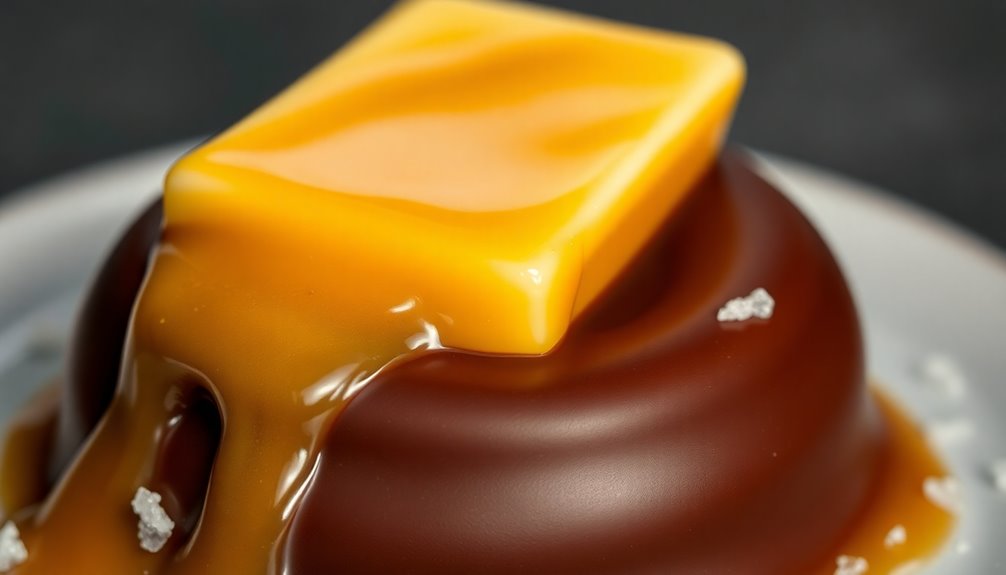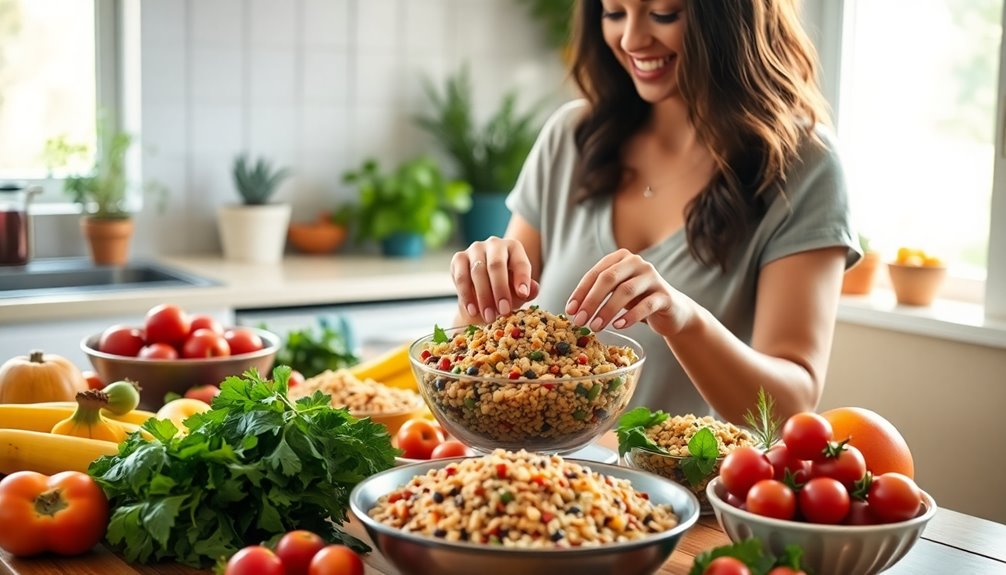Butter plays an essential role in desserts by enhancing both texture and flavor. It coats flour to prevent gluten development, resulting in tender cakes and flaky pastries. The rich, creamy taste of butter carries fat-soluble flavors, while its moisture content keeps desserts moist. Proper temperature is key—room temperature butter creams well, while chilled butter creates steam for airiness. Understanding these properties will elevate your baking. Discover more about techniques and types of butter to further improve your desserts.
Key Takeaways
- Butter provides rich flavor and enhances desserts through its creamy, slightly nutty taste and ability to carry fat-soluble flavors.
- The fat content of butter coats flour particles, preventing excessive gluten development and resulting in a tender texture.
- Proper butter temperature is crucial; room temperature butter creams well, while cold butter aids in achieving flakiness in pastries.
- The Maillard reaction occurs during baking, leading to golden-brown crusts and complex flavors, significantly enhanced by butter's unique melting properties.
- Grass-fed butter offers additional flavor and nutritional benefits, enriching desserts beyond standard butter.
The Role of Butter in Desserts
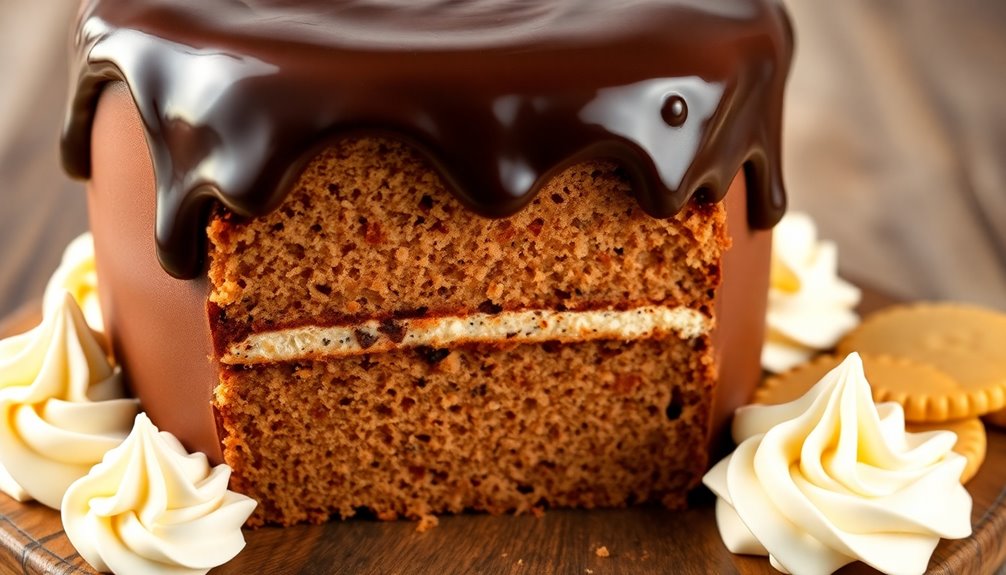
When you bake, butter plays an essential role in transforming your desserts into something extraordinary. Its rich flavor elevates your treats, making each bite more enjoyable.
The butterfat content in butter is vital; it coats flour particles, leading to tender cakes and flaky pastries. This process contributes to the desirable crumb structure that you crave in your baked goods.
Additionally, the water content in butter helps retain moisture, ensuring your desserts stay fresh and don't dry out. During baking, the Maillard reaction occurs, creating golden-brown crusts that deepen flavors. The creamy texture of butter is influenced by the emulsification process during churning, allowing it to blend seamlessly into your batter.
Different types of butter, like European-style with higher fat, can enhance the richness even more, giving you the perfect base for all your favorite desserts.
Butter's Impact on Texture
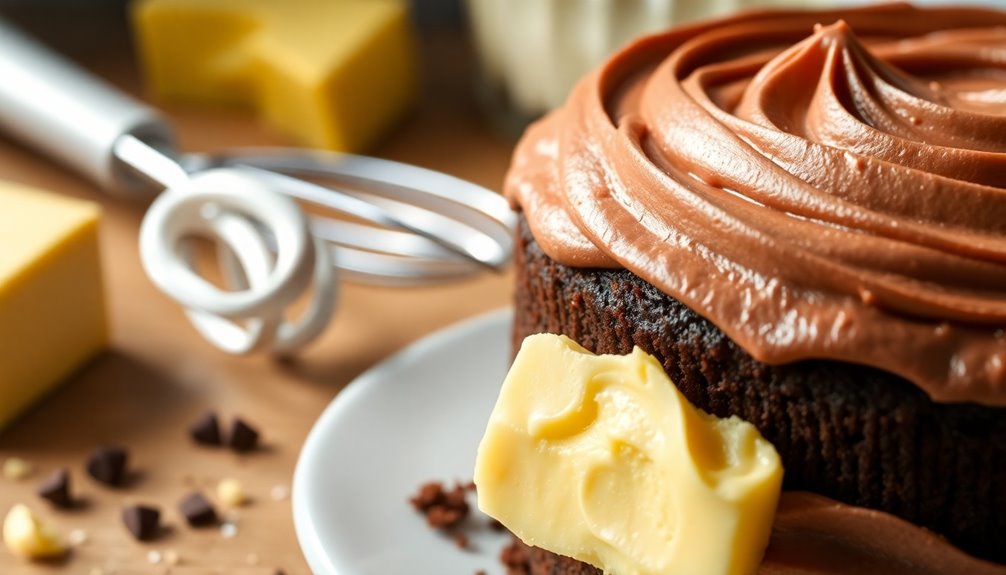
Although many factors influence the texture of baked goods, butter stands out as a key player. Its ability to coat flour particles helps prevent excessive gluten development, resulting in a softer texture.
When you use the creaming method, beating butter with sugar incorporates air and creates a light, airy structure in cakes and cookies, enhancing their overall texture.
Butter's high moisture content retains moisture in your baked products, preventing dryness and contributing to a tender crumb.
In flaky pastry, incorporating cold butter is essential; as it melts during baking, it produces steam that forms air pockets, creating those desirable flaky layers. Additionally, using high-quality grass-fed butter can further enhance the flavor profile and nutritional benefits of your desserts.
Flavor Enhancement Through Butter
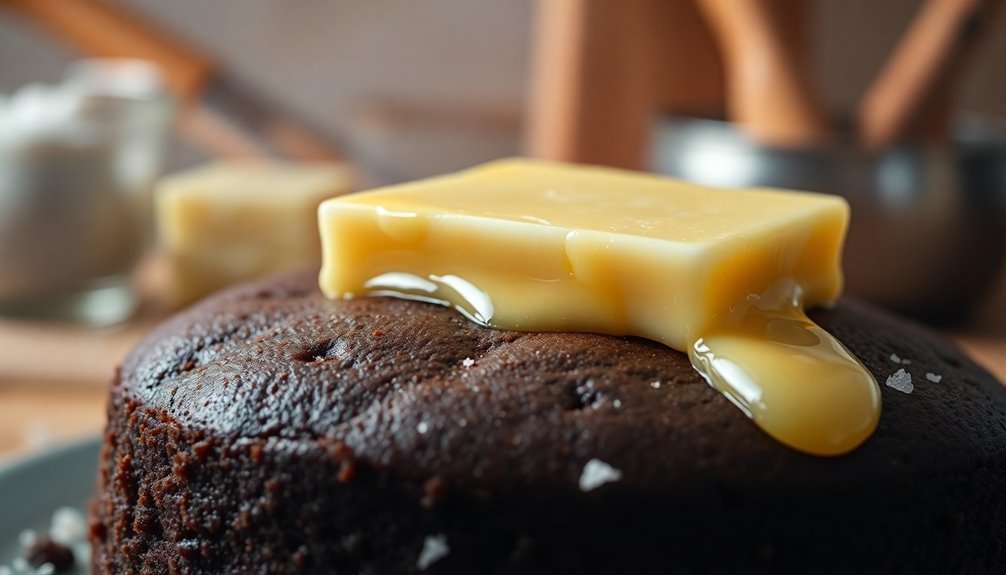
Butter isn't just a key player in achieving the perfect texture; it also greatly elevates the flavor of desserts. Its rich flavor compounds provide a creamy and slightly nutty taste that enhances your dessert's overall profile.
The fat content in butter carries fat-soluble flavors from other ingredients, amplifying their natural taste and aroma. Think about how sautéing garlic in butter transforms its flavor!
When you bake, the Maillard reaction occurs, creating golden-brown crusts and complex flavors that deepen your baked goods. Plus, butter's unique melting point coats your tongue, offering a velvety mouthfeel that enhances the sensory experience.
Combining butter with elements like salt can even intensify sweetness, making your treats even more satisfying. Additionally, using different types of butter can further influence the flavor and texture of your desserts.
The Importance of Butter Temperature
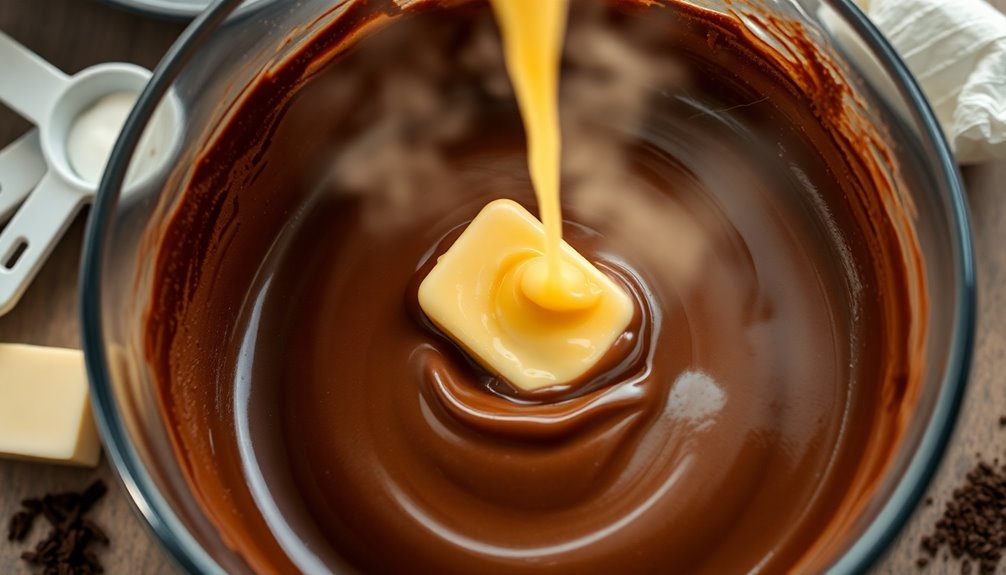
When you're baking, the temperature of your butter can make all the difference.
Using butter at the right consistency helps achieve the perfect texture, whether you want light and airy cookies or flaky pastries.
Understanding these ideal temperatures will elevate your dessert game and guarantee consistent results every time.
Optimal Temperatures for Baking
Getting the butter temperature just right is essential for successful baking. For ideal temperatures, room temperature butter should be around 65-68°F (18-20°C) to cream perfectly with sugar, creating light and tender cakes.
If you're making pastries, chilled butter at about 32°F (0°C) is vital. This temperature helps prevent too much gluten formation, resulting in those desirable flaky layers.
Be cautious with overly soft or melted butter; it can lead to excessive spreading in cookies, ruining their shape. Proper butter temperature also enhances emulsification, ensuring a uniform batter and even rise.
Don't overlook this detail—monitoring the temperature of butter affects the Maillard reaction, which is key for browning and flavor development in your baked goods. Additionally, using cultured butter can further enhance the flavor profile of your desserts, providing a distinctive tanginess that complements sweetness.
Effects of Butter Consistency
Achieving the right butter consistency is essential for baking success, as it greatly impacts the texture and flavor of your desserts. For flaky pastries, use chilled butter to create layers by trapping air and steam. Room temperature butter, ideally between 65-68°F, is perfect for soft, chewy cookies and tender cakes, allowing for better incorporation during the cream process. Melted butter, on the other hand, tends to make baked goods denser, while overly soft butter can lead to excessive spreading in cookies.
| Butter Consistency | Best For |
|---|---|
| Chilled | Flaky Pastries |
| Room Temperature | Soft Cookies, Tender Cakes |
| Melted | Dense Textures |
| Overly Soft | Flat Cookies |
Techniques for Incorporating Butter
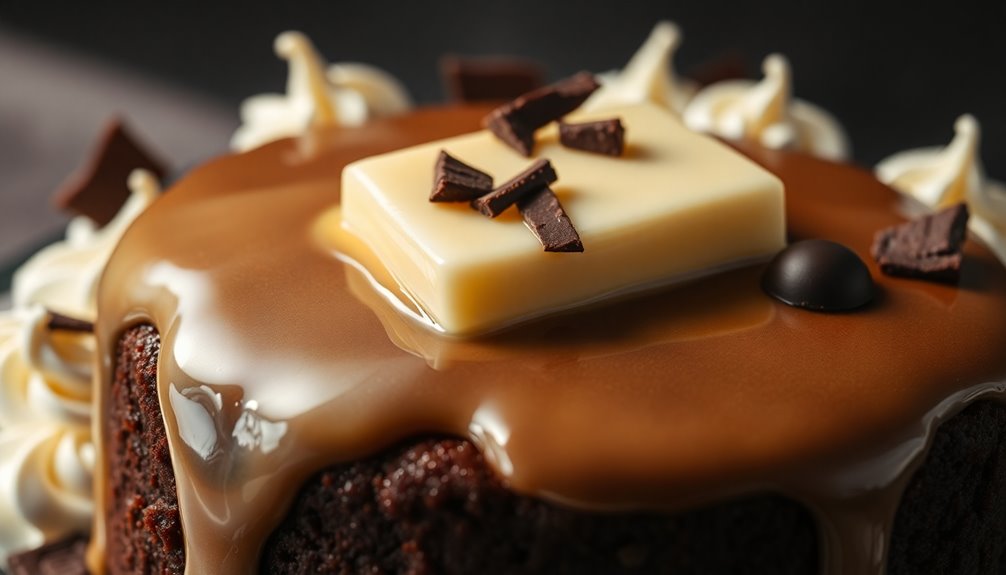
Incorporating butter properly can make a significant difference in the texture and flavor of your desserts. One effective method is creaming butter and sugar, which involves beating room temperature butter for 5-7 minutes. This technique incorporates air, yielding a light, airy texture in cakes and cookies.
For flaky pastries, cutting in cold butter with flour is vital; it coats flour particles and limits gluten development, ensuring tenderness. If you're working with laminated doughs like croissants, folding cold butter into the layers creates those flaky textures you love, as steam from the melting butter forms air pockets during baking. The importance of butter's role in culinary traditions highlights its longstanding significance in achieving desired textures and flavors in various recipes.
Types of Butter and Their Uses
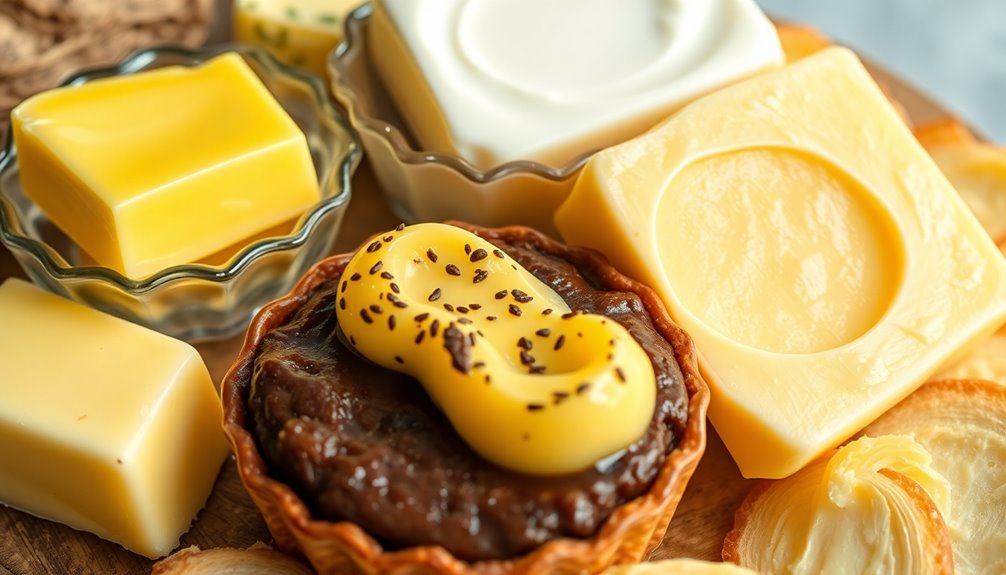
When it comes to baking, choosing the right type of butter can elevate your desserts considerably. Here's a quick guide to help you decide:
| Type of Butter | Butterfat Percentage | Best Uses |
|---|---|---|
| Unsalted Butter | 80% | Precise salt control |
| Salted Butter | 80% | Enhances flavor in cookies |
| European-style Butter | 82% or more | Richer flavor & creamier texture |
| American-style Butter | 80% | Consistent results in recipes |
| Clarified Butter | 100% | High-heat cooking and frying |
Using European-style Butter can enhance texture and moisture retention, while unsalted butter gives you control over flavor balance. Choose wisely to achieve the perfect dessert!
Common Pitfalls in Baking With Butter
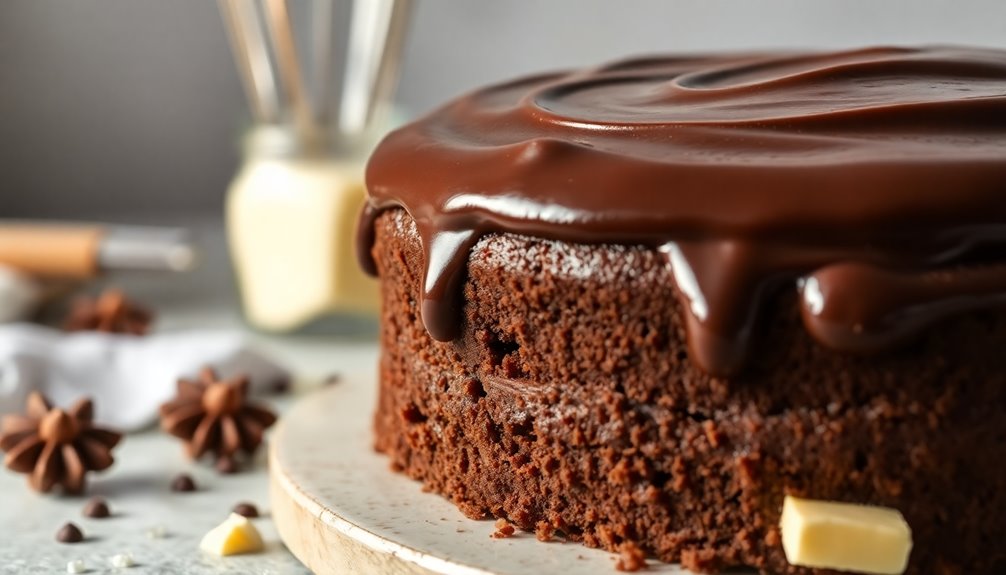
While butter is an essential ingredient in many desserts, using it incorrectly can lead to disappointing results. One common pitfall is using butter at the wrong temperature; if it's too cold, proper creaming becomes difficult, resulting in dense textures.
Conversely, if you over-cream the butter and sugar, your cookies might spread too much during baking due to excessive aeration. Don't forget to scrape the bowl while mixing, as neglecting this step can cause uneven ingredient distribution, impacting your dessert's overall texture.
Additionally, using melted butter in recipes that require room temperature or cold butter can lead to denser textures and unwanted spreading. Pay attention to butter temperature to achieve the desired flakiness in pastries and tenderness in cakes.
Frequently Asked Questions
How Does Butter Enhance Flavor?
Butter enhances flavor by introducing rich, creamy notes that elevate your baked goods. Its fat content carries and amplifies the natural tastes of other ingredients, making flavors like vanilla and chocolate more pronounced.
When you bake, the Maillard reaction creates a golden crust and develops complex flavors, adding depth. Plus, the subtle umami notes in butter make your desserts more satisfying, giving them a luxurious mouthfeel that you can't resist.
What Is the Science Behind Butter in Baking?
When you bake with butter, its high fat content coats flour proteins, creating a tender texture.
By using the creaming method, you incorporate air, making your cakes and cookies lighter. As butter melts, its water content turns to steam, helping your pastries rise.
Plus, during baking, the Maillard reaction produces that golden-brown crust and enhances flavor.
Choosing the right type of butter can also elevate your baked goods' overall taste and texture.
What Is the Function of Butter in Desserts?
Butter's like a warm hug for your desserts. It brings rich flavor and creamy texture, making everything taste better.
When you mix butter into your batter, it coats the flour, helping to create a tender crumb. It also traps air during creaming, giving cakes and cookies that light, airy quality.
Plus, its moisture keeps your treats fresh longer. Simply put, butter's essential for achieving that perfect balance of flavor and texture.
What Is the Science Behind Butter Making?
When you make butter, you're engaging in a fascinating process. You start with cream and agitate it to disrupt fat globules, leading to a phase inversion where solid butter separates from liquid buttermilk.
Keeping the temperature around 20°C (68°F) is key for stability during churning. The fat composition, mostly saturated, gives butter its creamy texture.
This semi-solid consistency is essential for various culinary applications, enhancing both flavor and texture in your creations.
Conclusion
In the world of desserts, butter's like a warm embrace, wrapping your treats in rich flavor and delightful texture. It transforms simple ingredients into decadent creations, inviting you to savor each bite. By understanding its role and mastering techniques, you can turn your kitchen into a haven of sweetness. So, the next time you bake, remember: butter isn't just an ingredient; it's the golden thread that weaves together the magic of your favorite desserts.
